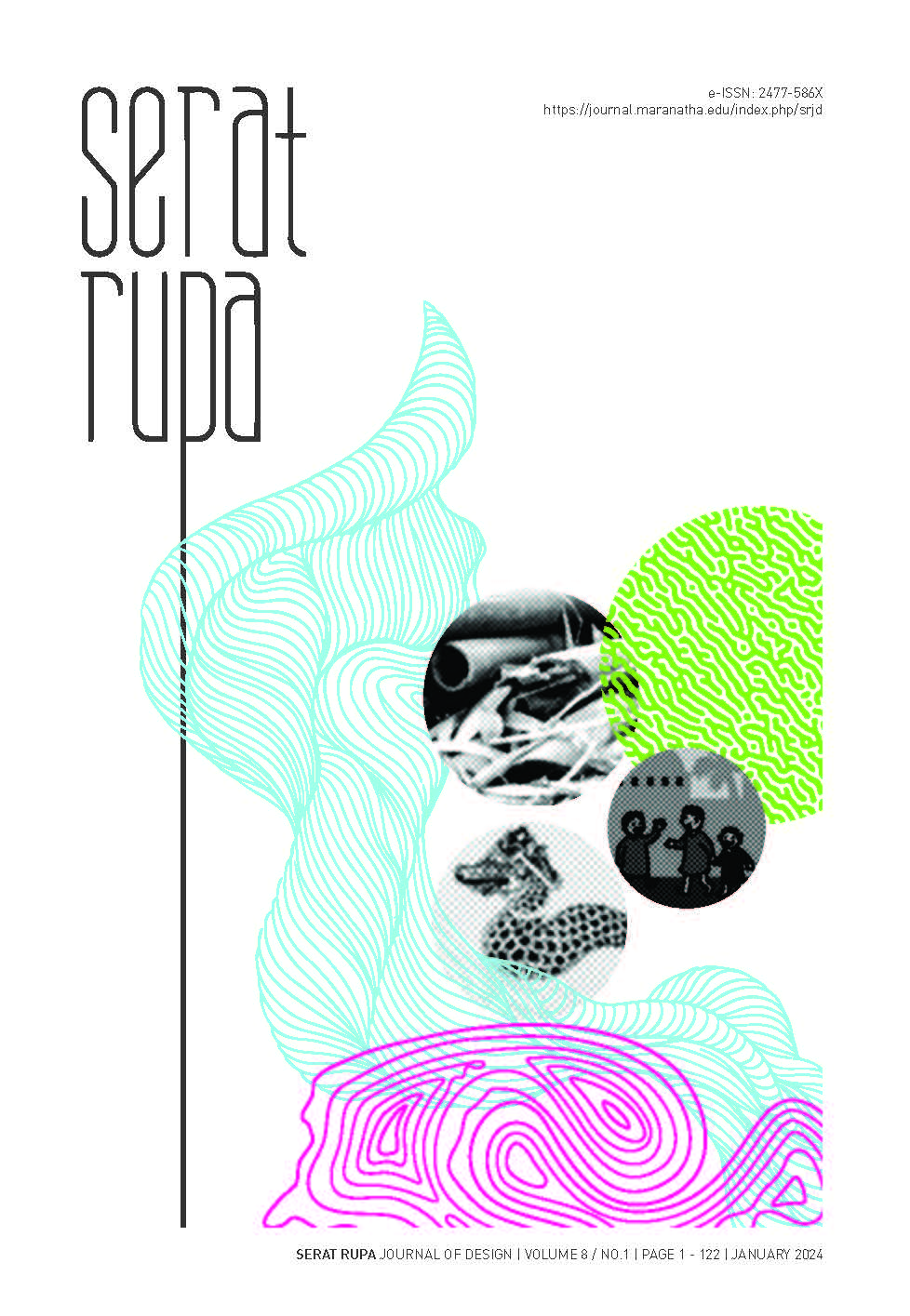Cirebon Mythology Visual Elements in The Design of Sitiwinangun Ceramic Crafts for Interior Products
Main Article Content
Abstract
Downloads
Article Details

This work is licensed under a Creative Commons Attribution-ShareAlike 4.0 International License.
References
Abdurrahman, P. R. (1982). Cirebon - Sejarah (1 ed., Vol. 1). Sinar Harapan
Adisasmito, N. D. H. S. (2010). Wayang Kulit Cirebon Estetika dan Konsep Visual
Al-Fazri, I., & Hajam. (2019). Kesenian Brai, warisan budaya leluhur Cirebon. Jurnal Yaqzhan: Analisis Filsafat, Agama dan Kemanusiaan, 5(2). https://doi.org/10.24235/jy.v5i2.5709
Almantara, H. A., Nansha, H., & Yana, D. (2020). Penataan workshop berbasis budaya lokal sebagai penguatan desa wisata Sitiwinangun Prosiding ISBI Bandung,
Almantara, H. A., Yana, D., & Nansha, H. (2022). Penataan Workshop Gerabah Sitiwinangun Kabupaten Cirebon sebagai Upaya Peningkatan Produktivitas Perajin Lokal (Organizing of Sitiwinangun Cirebon Regency Pottery Workshop as an Effort to Increase the Productivity of Local Craftsmen).Prosiding Seminar Nasional Industri Kerajinan dan Batik Seminar Nasional Industri Kerajinan dan Batik,
Bahri, S. (2005). Rumah susun sebagai bentuk budaya bermukim masyarakat modern. Jurnal Sistem Teknik Industri, 6(3), 97-102.
Balsas, C. J. L. (2018). Entrepreneurial Urban Revitalization In Entrepreneurship and the Industry Life Cycle (pp. 329-340). https://doi.org/10.1007/978-3-319-89336-5_15
Bland, C. A., Roberts, A. L., Popelka-Filcoff, R. S., & Santoro, C. M. (2017). Early vitrification stages identified in prehistoric earthenware ceramics from northern Chile via SEM. Journal of Archaeological Science: Reports, 16, 309-315. https://doi.org/10.1016/j.jasrep.2017.09.011
Candy, L. (2006). Practice based research: A guide (Creativity and Cognition Studies, Issue. https://www.creativityandcognition.com/wp-content/uploads/2011/04/PBR-Guide-1.1-2006.pdf
Chamidah, N., Guntoro, B., & Sulastri, E. (2020). Marketing Communication and Synergy of Pentahelix Strategy on Satisfaction and Sustainable Tourism. Journal of Asian Finance Economics and Business, 7(3), 177-190. https://doi.org/10.13106/jafeb.2020.vol7.no3.177
D'Ercole, G., Garcea, E. A. A., Eramo, G., & Maria, M. I. (2017). Variability and continuity of ceramic manufacturing of prehistoric pottery from Upper Nubia, Sudan: An ethnographic comparison. Journal of Archaeological Science Reports, 16. https://doi.org/10.1016/j.jasrep.2017.04.012
Effendi, I. Z. (2023). Simbol multikulturalisme pada imaji hibrid paksi naga liman Keraton Kanoman Cirebon. Jurnal Seni Rupa Warna, 11(1), 1-24. https://doi.org/10.36806/jsrw.v11i1.167
French, M. M. (1925). Uses of ceramics in interior decorating: an interview with Lionel Robertson of Tobey Furniture Co. Journal of the American Ceramic Society, 8(9), 415-418. https://doi.org/10.1111/j.1151-2916.1925.tb16781.x
Gultom, P., & Tamara, P. (2022). Analisis teknologi dalam industri kecil kerajinan gerabah. Industri Inovatif, 12(2), 127-133. https://doi.org/10.36040/industri.v12i2.4553
Hasbunallah, A. (2019). Nilai historis-sosiologis Bendera Macan Ali dan Dunia Mistik Masyarakat Cirebon (memaknai ulang Konsep Islam Kejawen). Jurnal Tamaddun : Jurnal Sejarah Dan Kebudayaan Islam, 7(2), 348-361. https://doi.org/10.24235/tamaddun.v7i2.5502
Hasyim, R. S. (2011). seni tatah dan sungging wayang kulit cirebon : pengantar reka visual dan makna simbolik / rafan s hasyim. Dinas Kebudayaan Pariwisata Pemuda dan Olah Raga.
Hendriyana, H. (2022). Metodoe penelitian penciptaan karya practice-led research and practice-based research seni rupa, kriya dan desain (Revisi ed.). Penerbit Andi.
Ho, D., & Hou, H. (2019). Enabling sustainable built heritage revitalisation from a social and technical perspective: A case study. Facilities, 37(11/12), 704-722. https://doi.org/10.1108/F-05-2017-0055
Irawati, D. R., Hakim, A., & Rokoyah, K. (2022). Sistem Aplikasi Pengenalan Sejarah Dan Kebudayaan Cirebon Berbasis Web. Journal of Artificial Intelligence and Innovative Applications (JOAIIA), 3(2), 152-156.
Iryana, W., Mustofa, M. B., & Anwar, M. S. (2023). Budaya Bendawi Pra Islam di Keraton Cirebon Indonesia. Bulletin of Indonesian Islamic Studies, 2(1), 19-38. https://doi.org/10.51214/biis.v2i1.503
Jb., M. C. (2015). Spiritualitas Islam dalam budaya wayang kulit masyarakat Jawa dan Sunda. Jurnal Sosiologi Agama, 9(1), 38-61. https://doi.org/10.14421/jsa.2015.091-03
Kelsey, D. (2016). Hero Mythology and Right-Wing Populism. A discourse-mythological case study of Nigel Farage in the Mail Online. Journalism Studies, 17(8), 971-988. https://doi.org/10.1080/1461670X.2015.1023571
Koesoemadinata, M. I. P. (2013). Wayang Kulit Cirebon: Warisan Diplomasi Seni Budaya Nusantara. ITB Journal of Visual Art and Design, 4(2), 142-154. https://doi.org/10.5614/itbj.vad.2013.4.2.6
Kriegesmann, J., & Kratz, N. (2015). Definition, Systematik und Geschichte der Keramik: Einteilung der Keramik nach werkstoffspezifischen Gesichtspunkten (Definition, Classification and History of Ceramics: Material-Specific Aspects). Keramische Zeitschrift, 67(4), 227-230. https://doi.org/10.1007/BF03400377
Laba, I. N., Suardina, I. N., & Karuni, N. K. (2022). Reaktualisasi Motif Ornamen Peninggalan Puri Agung Karangasem Dalam Penciptaan Tegel Gerabah. Seminar Bali-Dwipantara Waskita,
Li, B., Hu, W. P., & Li, L. Q. (2012). Application of Glass-Ceramic in Interior Design. Advanced Materials Research, 627, 655-658. https://doi.org/10.4028/www.scientific.net/AMR.627.655
Mesra, M., Kartono, G., & Ibrahim, A. (2022). Penerapan ornamel tradisional Sumatera Utara pada toples makanan sebagai sarana revitalisasi. Gorga : Jurnal Seni Rupa, 11(1). https://doi.org/10.24114/gr.v11i1.33639
Murwanti, A. (2017). Pendekatan practice-led research sebuah upaya fundamental untuk mengatasi ketimpangan antara praktik penciptaan seni rupa dan publikasi akademik di Indonesia Seminar Nasional Seni dan Desain: “Membangun Tradisi Inovasi Melalui Riset Berbasis Praktik Seni dan Desain”
Ngan, H. N., & Minh, N. T. (2021, 20 September 2021). The applicability of ceramic tiles in the contemporary interior – Exterior design in Ho Chi Minh City, Vietnam.

